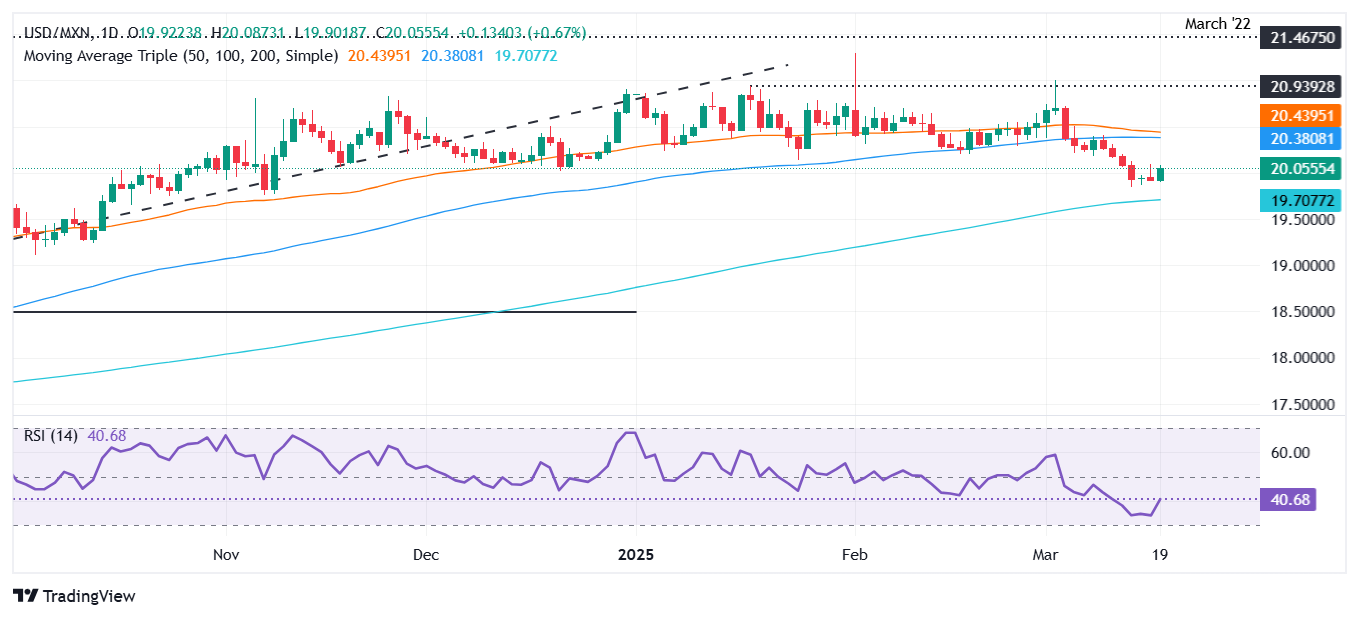Mexican Peso falls as traders reduce risk ahead of Fed rate decision
- Mexican Peso down 0.53%, USD/MXN hits 20.00 as markets await FOMC decision.
- US Dollar rises 0.47% to 103.72 on DXY; global equities rally amid Fed uncertainty.
- Banxico's next move in focus; Mexico’s Aggregate Demand and Private Spending data are due Thursday.
The Mexican Peso (MXN) lost some ground against the US Dollar (USD) in early trading on Wednesday as market players awaited the US Federal Open Market Committee’s (FOMC) monetary policy decision, hence reducing their exposure to high-beta currencies like the Peso. The USD/MXN trades back above 20.00, up 0.53%.
Global equities register gains, unusual on a Fed decision day, while the Greenback recovers some ground as depicted by the US Dollar Index (DXY) rising 0.47% to 103.72. Aside from the Fed, the Mexico and US economic dockets are absent.
USD/MXN traders will pay attention to the Fed, which is expected to hold rates unchanged at the 4.25%-4.50% range. In the latest Summary of Economic Projections (SEP), officials projected just two rate cuts in the year. Still, doubts linger after Fed policymakers emphasized that policy is well positioned and that they’re not in a rush to resume interest rate cuts.
On Thursday, Mexico’s economic docket will feature the release of Aggregate Demand and Private Spending data. The data could shed some light on current economic conditions and give some cues about Banco de Mexico’s (Banxico) next policy move in the March 27 monetary policy meeting.
Dail digest market movers: Mexican Peso on the defensive amid strong US Dollar
- The Organization for Economic Cooperation and Development (OECD) revealed earlier this week that US tariffs on Mexican products could spur a recession in Mexico. If duties remain unchanged, the OECD projects Mexico’s economy would shrink -1.3% in 2025 and -0.6% in 2026.
- Last Wednesday, Mexican Finance Minister Edgar Amador Zamora said the national economy is expanding but is showing signs of slowing down due to trade tensions with the US.
- Traders had priced the Fed to ease policy by 57 basis points (bps) throughout the year. Nevertheless, President Donald Trump's inflation-prone US trade policies could prevent the US central bank from continuing its cutting rates cycle and waiting to assess the impact on the economy.
- So far, an Atlanta Fed model updated on March 18 shows that the Gross Domestic Product (GDP) is expected to contract -1.8% in Q1 2025.
USD/MXN technical outlook: Mexican Peso retreats as USD/MXN climbs above 20.00
USD/MXN seems to have bottomed near the 19.89–20.00 range as traders await a fresh catalyst. A hawkish tilt by the Fed could refresh weekly highs and clear the path to challenging the 100-day Simple Moving Average (SMA) at 20.35. If surpassed, the next stop would be the 50-day SMA at 20.42.
Conversely, if USD/MXN tumbles beneath 19.90, traders could expect a fall to test the 200-day Simple Moving Average (SMA) at 19.65. Once hurdled, the next key support levels would be 19.50, 19.00, and the August 20, 2024 low at 18.64.

Mexican Peso FAQs
The Mexican Peso (MXN) is the most traded currency among its Latin American peers. Its value is broadly determined by the performance of the Mexican economy, the country’s central bank’s policy, the amount of foreign investment in the country and even the levels of remittances sent by Mexicans who live abroad, particularly in the United States. Geopolitical trends can also move MXN: for example, the process of nearshoring – or the decision by some firms to relocate manufacturing capacity and supply chains closer to their home countries – is also seen as a catalyst for the Mexican currency as the country is considered a key manufacturing hub in the American continent. Another catalyst for MXN is Oil prices as Mexico is a key exporter of the commodity.
The main objective of Mexico’s central bank, also known as Banxico, is to maintain inflation at low and stable levels (at or close to its target of 3%, the midpoint in a tolerance band of between 2% and 4%). To this end, the bank sets an appropriate level of interest rates. When inflation is too high, Banxico will attempt to tame it by raising interest rates, making it more expensive for households and businesses to borrow money, thus cooling demand and the overall economy. Higher interest rates are generally positive for the Mexican Peso (MXN) as they lead to higher yields, making the country a more attractive place for investors. On the contrary, lower interest rates tend to weaken MXN.
Macroeconomic data releases are key to assess the state of the economy and can have an impact on the Mexican Peso (MXN) valuation. A strong Mexican economy, based on high economic growth, low unemployment and high confidence is good for MXN. Not only does it attract more foreign investment but it may encourage the Bank of Mexico (Banxico) to increase interest rates, particularly if this strength comes together with elevated inflation. However, if economic data is weak, MXN is likely to depreciate.
As an emerging-market currency, the Mexican Peso (MXN) tends to strive during risk-on periods, or when investors perceive that broader market risks are low and thus are eager to engage with investments that carry a higher risk. Conversely, MXN tends to weaken at times of market turbulence or economic uncertainty as investors tend to sell higher-risk assets and flee to the more-stable safe havens.

